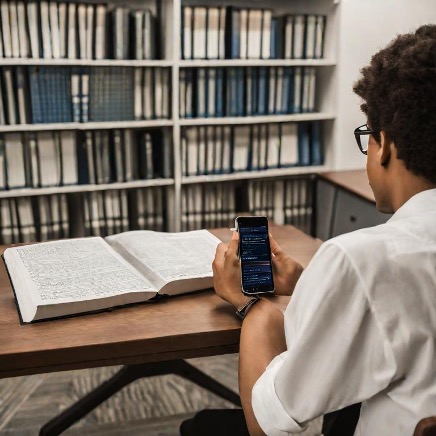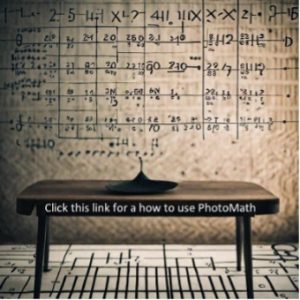13 How to Gain Confidence and Reduce Anxiety using PhotoMath.
Amber Joanette
Image created with Runway ML image creator.
Prompt: Student taking a photo with their cellphone of calculus textbook page at their desk. View is from over the shoulder.
Introduction
PhotoMath is a game changing AI powered tool that simplifies mathematics for students and learners. Snap a quick photo of a math problem, and it will provide a step-by-step process. Including solutions, explanations, and interactive graphs. But it is not just a problem solver; PhotoMath offers a comprehensive learning experience with tutorials and practice exercised for various math subjects. PhotoMath creates an environment where mathematics is accessible, enjoyable, and empowering, making it an invaluable companion for anyone seeking to conquer math challenges and build confidence in their math skills.
Connection to Curriculum
PhotoMath connects to the curriculum by providing students with step-by-step solutions, reinforcing math concepts, offering practice and instant feedback, and serving as a supplementary resource for better understanding of math equations. In addition, it allows parents or guardians to be more hands on with their children’s homework. Even if perhaps they are not as knowledgeable on the subject. Furthermore, it will allow students a chance to get the help they need in larger classes where a teacher perhaps may not be able to set aside time for each students. As well as it provides a great tool and asset to distance learning. PhotoMath connects to a plethora of outcomes and indicators such as:
- FP10.09- Equations of Linear Relations: Photomath can provide step-by-step process of graphical solutions as well as provide information on how equations are formed. With Photomath students can check their work when given specific points or slopes.
- P20.8-Quadratic Functions: Photomath can help students understand quadratic functions, including their vertex, domain, range, and other characteristics. It can provide graphical solutions, which aid in comprehending the properties of quadratic functions.
- P20.10-Sequences and Series: While Photomath primarily focuses on algebra, it may indirectly contribute to understanding arithmetic and geometric sequences and series by enhancing mathematical problem-solving skills.
In addition PhotoMath relates to plenty indicators as well such as:
- C30.4- Differentiation: Photomath is capable of providing solutions for differentiation problems helping students understand how to calculate derivatives and comprehend the concept f a slope as a rate of change.
Furthermore, PhotoMath relates to the cross curricular competencies by helping students develop numeracy and mathematical literacy skills by providing solutions to math problems. This can enhance their understanding of mathematical concepts, equations, and operations, enabling them to develop their literacies. Through guiding students through step-by-step solutions to math problems it encourages them to develop thinking, and helps them analyze, evaluate, and understand the logical steps required to solve math equations. Students will build self- efficacy by using PhotoMath which can contribute to them developing identity and interdependence seen through their positive self-identity and confident in their math skills. Lastly students will develop social responsibility through using PhotoMath in the proper way, not used as an aid for cheating or plagiarism, students can understand the importance of academic honestly.
Lastly, PhotoMath relates to the broad areas of learning by supporting the idea of continuous learning, where individual’s can access help and guidance on math problems, whenever students need it which will create lifelong learners. In regard to sense of self and engaged citizens the app itself does not direct relalte to these however, students can use this app to gain confidence in their skills. Making them more interactive in their class therefore giving them a sense of community. As well, students can further understand math allowing them to obtain more education and easier access to post-secondary education, where they will get careers and become active parts of the community and thus engaged citizens.
Affordances and Constraints
PhotoMath provides students with several valuable affordances. It assist in solving math problems step-by-step, offering instant feedback and detailed explanations. With coverage of a wide range of mathematical topics, it supports learning at various levels. Its accessibility as a mobile app makes it a convenient tool for on the go learning and practice, enhancing math skills and understanding. Additionally, PhotoMath can be a great asset during online or distance learning. PhotoMath also comes with certain constraints. While it aids in problem-solving, it can potentially foster dependency on the app and discourage independent thinking. PhotoMath is primarily designed for mathematics and does not cover other subjects. There is a risk of misuse for cheating purposes, which educators should be aware of. Moreover, Photomath does not comprehensively teach underlying mathematical concepts, necessitating a balanced approach alongside regular classroom instruction and study. (add thoughts on workarounds for dependency on the app and discouraging independent thinking)
The Process
- Download and Install Photomath: Start by downloading and installing the photomath app on your mobile device. It’s available on both iOS and Android platforms.
- Launch the App: Open the Photomath app by tapping its icon on your device’s home screen.
- Capture or input a Math Problem: To solve a math problem, you have two primary options:
- Capture a photo: use your devices camera to capture a clear photo of the handwritten or printed math problem you want to solve.
- Manual input: Alternatively, you can manually type the math problem into the app using the keyboard.
- Analyze and Process: Photomath will then analyze the math problem you provided, whether it’s from the captured photo or manual input.
- View step-by-step solution: After processing, Photomath will display a step-by-step solution to the math problem. Each step is explained in detail, helping you understand the process.
- Interact with the Solution: you can navigate through the steps, zoom in on one specific part of the solution, or rewind to review previous steps.
- Verify and Learn: As you go through the solution, you can verify your understanding and learn how to solve similar problems in the future.
- Save or Share: If needed, you can save the solution or share it will others, such as classmates or teachers.Conversations with chat bots are not typically required to use Photomath. The process mainly involves interacting with the app’s user interface. However, if you have questions or need assistance with using the app, you may refer to the in-app help resources or contact Photomath’s customer support.
Prompt Engineering
Photomath should be used as a learning aid rather than a shortcut, capture clear photos of problems, and actively practice problem solving. Exploring all the features is key, especially for complex problems, as well as seeking clarification when needed. When combined with traditional study methods and learning goals it can be utilized to periodically review your progress. By avoiding over usage of the app it can be an asset to your learning and using it as a tool it can be as asset for your learning experience providing tools for understanding and skill building.
Recommendations
The use of the app itself will be support enough for user’s to ensure that can gain help with their math problems. However there are some addition resources that may further enhance their learning such as:
- YouTube Videos
- Sources of math skill building
- Math skill buildings apps
- Creating or joining an online study group to help you and others further understand math problems
Informative presentation
References:
Accessibility Services. (2020, November 4). How to Use PhotoMath [Video]. YouTube.
https://www.youtube.com/watch?v=V71F0kauzac
Desmos. (n.d.). Desmos. Retrieved October 15, 2023, from
https://www.desmos.com/
Gonzales, M.A.S. (2023). Enhancing Mathematical Skills of the Students Through Digi-Tech Apps. Retrieved October 2, 2023, from file:///C:/Users/ajoanett/Downloads/1001041720223547.pdf
Khan Academy. (n.d) Khan Academy. Retrieved October 15, 2023, from
https://www.khanacademy.org
PhotoMath. (2015, December 3). PhotoMath 2.0 [Video]. YouTube.
https://www.youtube.com/watch?v=er7x11Nbi3I
PhotoMath. (n.d) PhotoMath. Retreived October 3, 2023, from
https://photomath.com/en
Runway ML. (n.d) Home. https://runwayml.com/. Accessed October 3, 2023.
Acknowledgement of AI Use
I used Chat GPT to help me find useful AI tools for the classroom. Choosing Photomath stuck to me as math is not my strongest subject. Chat GPT also aided me in summarizing readings as well as the curriculum outcomes and indicators. Additionally Chat GPT was used to bounce my own ideas off and was used to generate other recommendations to use with Photomath. I also used Runway ML to create the photo on my page with the prompt, “Student taking a photo with their cellphone of calculus textbook page at their desk view is from over the shoulder.” The second generated photo was used with Runway ML with the prompt “photo with math equations and the words, “How To Link”.” As well as many other attempts to find the right photo in Runway ML.


